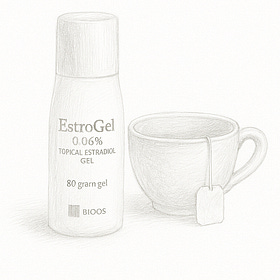What is Adenomyosis?
And why are so many women in their 40s suddenly being diagnosed with it?
I’d never heard the word adenomyosis until I was told I had it.
In 2023, after months of heavy, energy-sapping periods that were getting worse by the cycle, I finally had a pelvic ultrasound. I was 45, and what I thought was just “getting older” turned out to be something else entirely.
When I say heavy, I don’t mean “a bit more than usual.” I mean crime scene heavy. Not being able to leave the house on day one or two because I’d bleed through a tampon and pad within 20 minutes. Having to sleep with towels under me. Getting up multiple times a night to change tampons. Planning my life around my period because it had become that unpredictable and unmanageable.
The ultrasound results came back with one unfamiliar word: adenomyosis.
It’s a mouthful, but here’s what it means: the tissue that normally lines your uterus (the stuff that sheds during your period) starts growing into the muscular wall of the uterus itself. So every month, instead of that lining neatly shedding, it thickens and bleeds inside the muscle, causing inflammation, swelling, pain, and that relentless, heavy bleeding.
No wonder my iron was in the basement.
Until quite recently, adenomyosis was something many women were only diagnosed with after a hysterectomy, when the tissue could be examined under a microscope. Which meant for decades, most of us were told it was “just heavy periods” or “normal for your age.”
Now, with advances in high-resolution pelvic ultrasounds and MRIs, more women are finally getting answers earlier.
And unsurprisingly, the majority of those diagnoses are happening in our 40s, the decade where hormones start to fluctuate wildly and where pregnancies, births, and uterine procedures may have left their mark.
By this stage of life, our bodies have been through a lot and those microscopic pathways between the uterine lining and muscle wall can form more easily. Add in surges of oestrogen during perimenopause and you’ve got the perfect storm for adenomyosis to make itself known.
At first, my treatment plan was to regulate my hormones with a birth control pill called Qlaira. My gynaecologist offered me HRT at this time too, but I was scared to take it. I thought menopause and this stage of life were “natural”, something to be embraced, not medicated. Plus, I’d heard the word. HRT was cancer-causing and dangerous. Or so I thought.
I thought I could just power through.
Qlaira mimics a healthy menstrual cycle, with changing doses of estrogen and progestin throughout the month. The idea was to regulate my hormones and ease the bleeding. The reality? For six months, I lived with a headache or, on the lucky days, a migraine. I didn’t realise until I came off it that the pill was the culprit.
So, I did what so many women do: I learned to live with the heavy bleeding. I designed my life around my period. My tracker told me when I was due, and I’d make sure I didn’t have much planned on those days. Not ideal, but it was the only way to stay functional.
Two years later, at 47, my “regular” periods suddenly became… irregular. I went from clockwork cycles to nothing. 100 days without a bleed. After a panicked pregnancy test to rule out a surprise baby, I did a menopause scorecard, and my gynaecologist confirmed what I hadn’t expected to hear so soon:
I was in the late stages of perimenopause.
That shocked me. I thought perimenopause could drag on for five to ten years, and that menopause didn’t usually hit until around 51. I couldn’t quite get my head around the idea that my fertile years were almost over.
So I finally started HRT, something I’ve already written a bit about. Not just because I hadn’t bled for 100 days but this was further confirmation I was deep in peri. Having a super high score on the menopause symptom scorecard was the clincher. I’ve shared a bit about my symtpoms, but you can listen again here if you like.
At first, I tried the standard Prometrium (a natural progesterone), but I couldn’t tolerate it. Then I was offered Slinda, a progestin-only birth control pill. One of its side effects? It stops bleeding altogether.
Which, for me, was both a blessing and a bit of a head spin. After years of flooding through pads and planning my life around my period, suddenly I wasn’t bleeding at all. My iron levels stabilised. My energy improved. My washing machine got a break.
Slinda is also used for women with PMDD (premenstrual dysphoric disorder) or mood fluctuations, and it’s had great success in regulating hormones and improving mood stability. Something I’ve definitely noticed.
So while it’s a little odd not knowing exactly where I am in my cycle anymore, I’ll take it. The positives far outweigh the negatives.
We don’t talk enough about how confusing this middle stage of life can be. One minute you’re bleeding like a stuck pig, the next you’ve gone 100 days without a period, and you’re Googling “can you get pregnant in perimenopause.”
Adenomyosis, hormones, perimenopause, it’s all connected. And it’s only when we start sharing these stories that more women realise what’s actually normal (and what’s not).
Because we deserve more than to be told to “just put up with it.”
You may also like…
Lifting the Estrogen Veil: Starting MHT and Feeling Myself Again
One week ago, I started HRT (now called Menopause Hormone Treatment or MHT), and it feels like I've been reborn.
Antidepressants or Estrogen? The Silent Psychological Toll of Perimenopause
There’s this weird moment a lot of us go through, but we don’t always connect the dots. We start to feel like we’re falling apart in ways we can’t explain.








Robyn, I hope this works and helps you feel better throughout the rest of your period-menopause journey.
I now realise that I must have had adenomyosis about 20 years ago (I'm 65 now) - what I went through sounds exactly like this. Bleeding so heavy I could barely leave the bathroom! Was put back on the pill to control the bleeding (never diagnosed with anything), and when I came off it after maybe a year or so, no periods at all.